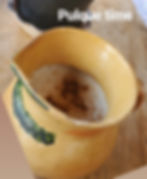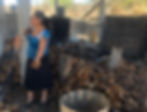From Clay Pots to Pulque: A Brief Take on the Ancient Roots of Ancestral Beverages in Mesoamerica
- Jimmie Munoz, Jr.
- Jul 17
- 5 min read
A Wall Street Journal article titled “The Growing Buzz Around Ancestral Wines” tells us that climate change has challenged modern agricultural models and consumer trends to increasingly favor sustainability, and the wine world has begun to look back to its roots. Ancestral wines—produced using pre-industrial methods, minimal intervention, and natural fermentation—are making waves among sommeliers and enthusiasts who prize authenticity and heritage. The movement isn’t just about the taste. It’s about reconnecting with the land, the people, and the cultural continuity that spans thousands of years.
This growing interest in ancestral production echoes beyond the vineyards of Georgia, Armenia, and France. In fact, long before grapes were fermented in clay amphorae in the Caucasus, Indigenous cultures across Mesoamerica were already mastering the use of agave, not only for food and fiber but for fermentation, and possibly even distillation. These practices form the cultural and historical backbone of today’s artisanal mezcal and pulque production—a fact worth celebrating and supporting.

Ancient Vessels and Theories from Colima
Among the most intriguing pieces of evidence supporting the theory of pre-Hispanic agave distillation are ceramic artifacts discovered in Colima, in western Mexico. It’s a topic that I cover at my guided tastings whenever I’m presenting ancestrally produced mezcal. In Colima, archaeologists uncovered hollow clay pots with side spouts that resemble components of archaic stills. These vessels, dated several centuries before the arrival of the Spanish, challenge the conventional narrative that distillation was introduced solely by Europeans.
Though conclusive evidence for pre-Colombian distillation has yet to be found, the possibility that ancient Mesoamerican cultures independently developed early distillation methods is fascinating. These theories offer powerful inspiration for archaeologists and agave spirits enthusiasts alike, bridging past and present through cultural heritage and indigenous innovation.

Evidence of Fermentation at Xochitécatl-Cacaxtla ~800 BCE–200 CE
While distillation remains a point of scholarly debate, the archaeological record firmly supports widespread fermentation in ancient Mesoamerica. Fermentation is the step immediately prior to distillation. Meaning, pre-Hispanic cultures knew how to process agave to evoke its nutritional and lightly intoxicating qualities. The pre-Hispanic site of Xochitécatl-Cacaxtla in the present-day state of Tlaxcala offers compelling evidence. Researchers have identified household ovens and ceramic vessels likely used for processing agave. The structure and distribution of these findings suggest a domestic, community-based model of agave fermentation.
These remains align with ethnographic data and historical accounts indicating that agave, or maguey, was routinely baked in stone-lined pits and then fermented. The processes weren’t just utilitarian; they were embedded in the cycles of communal and ceremonial life, reinforcing social cohesion and spiritual belief systems. This is reflected in mesoamerican divine beings like Mayahuel (goddess associated with agave), Xochipilli (god associated with fermented beverages), and of course the famous Quetzalcoatl.

Pulque: Mesoamerica's Ancestral Elixir
Pulque, the naturally fermented sap of the agave plant, holds a special place in Mesoamerican history. Archaeological and botanical studies suggest that pulque production may date back to at least 800 BCE. The Codex Borbonicus and other pre-Columbian texts depict rituals involving pulque as a sacramental offering to the gods. Fermented pulque is just one step away from becoming mezcal. This is why the intriguing findings of special clay pots and accompanying clay cups found in burial sites in Colima have got archaeology-minded mezcal enthusiasts thinking that some Mesoamerican cultures took the step to distill their pulque, thus yielding what we know today as “Mezcal Ancestral” or mezcal produced in the ancestral fashion.
But pulque was more than a ritual beverage. In rural areas, it served as a crucial source of hydration and nutrition. Fresh, unpasteurized pulque contains B vitamins, protein, and beneficial probiotics, making it an ideal supplement in traditional diets. It was even recommended for pregnant and lactating women, a testament to its perceived health benefits.
Of course, as fermentation continues, the drink becomes more alcoholic and less nutrient-dense. But in its freshest state, pulque stands as a rich and nourishing example of ancestral fermentation.

Agave's Widespread Role in Mesoamerican Life
Beyond fermentation and the pulque tradition, agave has played a monumental role in Mesoamerican society. Archaeological digs such as Guitarrero Cave in Oaxaca have yielded evidence of agave remains, confirming its role as a dietary staple. Ethnobotanical studies show that agave was and continues to be used for:
Fiber (for clothing, rope, construction)
Food (roasted hearts, sweet juices)
Tools (from spines and stalks)
Ritual (fermentation, offerings, sacred uses)
This multifaceted role is reinforced across dozens of pre-Hispanic sites. Whether in the stone ovens of the central valleys or the dry caves of the north, agave emerges as a symbol of resilience, sustenance, and cultural identity.

Conclusion: Ancestral Beverages as Living Heritage
While wine’s origin story may begin in the Cuacues or the middle-east region of Mesopotamia (modern day Iraq), Mesoamerica tells a parallel tale through agave. Today’s artisanal mezcaleros, pulqueros, and rural producers are the living heirs of an unbroken tradition that spans millennia. Their techniques, rooted in ancestral knowledge, honor the land and preserve biodiversity. They represent not only a flavorful legacy but also a blueprint for sustainable, community-led economic development.
As Chief of Passport Destilados, I am proud that we work with these rural producers to bring the story of ancestral beverages to international audiences. By supporting their craft, we honor ancient wisdom, promote cultural preservation, and contribute to a more equitable and sustainable future.
So the next time you sip an earthy mezcal or a fresh glass of pulque, remember: you are not just tasting a drink. You are participating in an ancient conversation.
Written by Jimmie Muñoz, Jr., archaeology enthusiast and founder of Passport Destilados, a company dedicated to promoting artisanal Mexican spirits and the people who make them.












